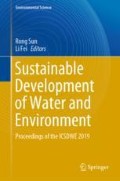Abstract
Environmental assessment of buildings and materials’ impacts is of great importance because of reduction of the negative influence of construction sector to the environment. The paper presents a study of the environmental evaluation of the vertical structures made of brick, aerated concrete and reinforced concrete as core wall materials. Two types of the insulation materials were considered whereas the material composition of the walls was designed to ensure the same thermal performance of the structure. For each material composition, the following environmental indicators were calculated per 1 m2 of the structure: the primary energy (PEI), the global warming potential (GWP) and the acidification potential (AP). The calculation was based on the unit data originating from a selected Life cycle analysis (LCA) data-base. Multi-criterial analysis was applied to identify the most appropriate composition when considering also the physical parameters of the walls. The findings revealed that the most environmentally sound wall composition was represented by aerated concrete insulated by graphite polystyrene.
Access this chapter
Tax calculation will be finalised at checkout
Purchases are for personal use only
References
Abanda FH, Nkeng GE, Tah JHM, Ohanjah ENF, Manijia MB (2014) Embodied energy and CO2 analysis of mud-brick and cement-block houses. Energy 2(1):18–40
Abd Rashid AF, Yusoff S (2015) A review of life cycle assessment method for building industry. Renew Sustain Energy Rev 45:244–248
Asif M, Muneer T, Kelley R (2007) Life cycle assessment: a case study of a dwelling home in Scotland. Build Environ 42:1391–1394
Estokova A, Porhincak M (2015) Environmental analysis of two building material alternatives in structures with the aim of sustainable construction. Clean Techn Environ Policy 17:75–83
Gustavsson L, Joelsson A (2010) Life cycle primary energy analysis of residential buildings. Energ Build 42:210–220
ISO EN 15804:2012+A1:2013 Sustainability of construction works. Environmental product declarations. Core rules for the product category of construction products
Keun HY, Tae HK, Seung JR (2015) Analysis of lifecycle CO2 reduction performance for long-life apartment house. Env. Progress Sust Energ 34(2):555–556
Korviny P (2010) MCA7, v 2.6. Software, manual
Linkov I, Moberg E (2012) Multi-criteria decision analysis: environmental applications and case studies, 1st edn. CRC Press, Boca Raton
Mitterpach J, Štefko J (2016) An environmental impact of a wooden and brick house by the LCA Method. Key Eng Mat 688:204–209
Pujadas-Gispert E, Sanjuan-Delmás D, Josa A (2018) Environmental analysis of building shallow foundations: the influence of prefabrication, typology, and structural design codes. J Clean Prod 186:407–417
Sartori I, Hestnes AG (2007) Energy use in the life-cycle of conventional and low-energy buildings: a review article. Energ Build 39:249–257
Thormark C (2006) The effect of material choice on the total energy need and recycling potential of a building. Build Environ 41:1019–1026
Vilcekova S, Culakova M, Kridlova-Burdova E, Katunska J (2015) Energy and environmental evaluation of non-transparent constructions of building envelope for wooden houses. Energies 8:11047–11075
Waltjen T, Pokorny W, Zegler T, Torghele K, Mötzl H, Bauer B, Boogmann P (2009) Details for passive houses: A catalogue of ecologically rated constructions, 3rd edn. Springer, Wien
Acknowledgements
This research was funded by VEGA—Scientific Grant Agency of the Ministry of Education, Science, Research and Sport of the Slovak Republic and the Slovak Academy of Sciences, grant number 1/0648/17.
Author information
Authors and Affiliations
Corresponding author
Editor information
Editors and Affiliations
Rights and permissions
Copyright information
© 2019 Springer Nature Switzerland AG
About this paper
Cite this paper
Estokova, A., Paulikova, A., Singovszka, E. (2019). Environmental Impacts of the Selected Building Structures. In: Sun, R., Fei, L. (eds) Sustainable Development of Water and Environment. ICSDWE 2019. Environmental Science and Engineering(). Springer, Cham. https://doi.org/10.1007/978-3-030-16729-5_10
Download citation
DOI: https://doi.org/10.1007/978-3-030-16729-5_10
Published:
Publisher Name: Springer, Cham
Print ISBN: 978-3-030-16728-8
Online ISBN: 978-3-030-16729-5
eBook Packages: Earth and Environmental ScienceEarth and Environmental Science (R0)

